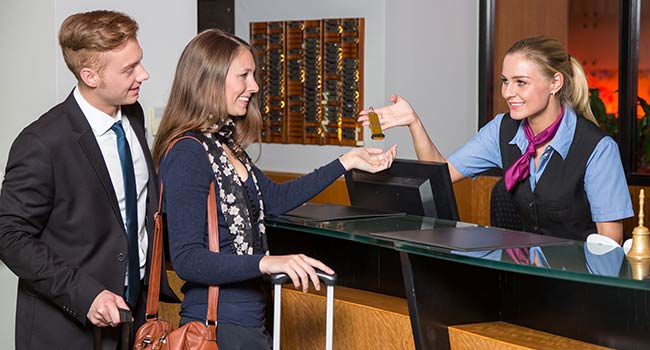In the second installment of the “Back to the Future” series, Marty, the unsuspecting time traveler, is propelled to the (then) futuristic year of 2015, where he encounters such advanced technology as holographic billboards and advertisements. Now, a couple of years later, holograms aren’t a steady component of digital marketing. However, we may not be too far off the mark.
Today’s hospitality digital marketing may not consist of a hologram of a Hilton rolling by on a hoverboard, but don’t scoff at the thought. Today, the lodging and tourism industry is heavily relying upon concepts once considered futuristic, such as virtual reality marketing and more.
We can’t take you to the future in a DeLorean, but we do have the luxury of sharing the knowledge and experience of several Phoenix experts from the Arizona Chapter of the Hospitality Sales and Marketing Association International (HSMAI) who are familiar with the latest in hospitality digital marketing.
Digital voice of the hospitality consumer
There is an element dominating digital marketing in hospitality for which experts adamantly agree. It may not be as sexy as virtual reality, but it’s potent and powerful: user-generated content (UGCs).
Research demonstrates that consumers spend an average of 5½ hours a day with UGCs – either listing their reviews or viewing those of others.
“As an agency trying to harness the power of the guest voice in purchasing decisions, our ability has been somewhat diminished in terms of advertising and marketing because of a review-driven market,” explains Richard Cassey, Commit Agency’s chief strategy officer.
 This realm of digital marketing is so commanding that it’s reported more than 50 percent of U.S. consumers put their trust in UGCs over any other information on a company website.
This realm of digital marketing is so commanding that it’s reported more than 50 percent of U.S. consumers put their trust in UGCs over any other information on a company website.
According to Cassey, hoteliers need to be proactive in strategizing ways to incorporate UGCs as part of their digital marketing plans. The question is, how?
“Hotels must harvest past guest stories, reviews and content and repurpose it for potential guests,” says Dave Spector, partner for Tambourine.
Tambourine, for example, recently launched a new tool, “TOUT,” to accomplish this very task by enabling hotels to obtain usage rights for UGCs on social media and is available to all Tambourine clientele.
There is a major benefit for the hospitality industry adopting UGCs into digital marketing algorithms.
“People trust user-generated content more than anything,” says Holly Zoba, vice president of sales and hospitality for Signature Worldwide. “For the hospitality industry, we invest so much for this type of digital marketing because of its measurability.”
Measurability indeed, and this is where social media makes its mark.
Social media and the 3 Ms
Social media in hospitality is measurable, marketable and mastered by the Millennials. Technically that’s four Ms, but more importantly, social media is as vital to hospitality digital marketing as “Doc” was to making the DeLorean time machine magical.
“If you ask hotels what social media channel produces the most profit, it’s Instagram,” Zoba says, who also chairs the HSMAI digital committee.
Zoba further explains that of all social media channels, Instagram has the most return on investment. Why? Because Instagram is driven by imagery, so it’s the perfect digital medium for hospitality properties to showcase product, services and experiences – through their own eyes, as well as UGCs.
Pinterest, also driven by imagery, has been effective in hospitality digital marketing ROI.
“Hotels can hook people in through images of what an ideal property, vacation or experience looks like,” explains Something New Media Partner James Lee. “Marriott has expertly utilized Pinterest to capitalize on exactly what consumers are looking for to build a vacation by making a vision board with some of the most sought-after images.”
Facebook, of course, continues to be a long-standing, steady social media stream and a fairly easy means of collecting consumer data analytics.
Back to the three Ms — we’ve got measurability, marketability – now what about those Millennials and their social media influence? Are they really that influential to the tourism industry? You bet your plutonium they are.
According to an article in Forbes, 94 percent of Millennial travelers use Facebook while traveling, and 71 percent use Instagram. Additional statistics show that Millennial tourists generate more than $180 billion in tourism revenue annually.
What’s the best way to capture this integral digital marketing demographic through social media?
“Millennials love seeing transparency and a bit of messy,” Lee says. “As producers in hospitality, we’re taught that nothing is supposed to appear imperfect. We can get caught up in being a little too careful in marketing to Millennials.”
“Millennial and GenX consumers are especially good at sniffing out BS hyperbole,” Spector adds, “so keep it real; keep it authentic.”
It’s also wise for hoteliers to heed the warning of Gerry Reed, TravelClick Inc., director of Southwest sales. “One social media channel does not fit all,” Reed says. “Each individual marketing campaign will have a different objective, which will ultimately affect which channel a hotel chooses to engage in.”
Something for which Lee agrees. “It’s currently difficult to find a digital paradigm that will be consistent across all social media platforms. It’s important to be more mindful of the message being delivered rather than the means.”
Now for the fun stuff
Can you virtually visit London and skip over to Maui in 90 seconds? According to Marriott, you can. And they aren’t the only hotelier to offer what they refer to as a 4D virtual- reality experience (through Oculus).
“Virtual reality is one of the most compelling digital marketing tools,” Lee says, “because, through a virtual walk-through rather than a video with actors, the end game is making people believe they will love being at the destination they’re experiencing.”
Compelling as it may be, is virtual reality commonplace in hospitality digital marketing?
“Everyone is still in the phase of wondering where it will fit in,” Cassey says. “Best Western made a jump about a year ago, offering virtual tours for all hotels in their portfolio in the latter part of 2016. It’s clearly the technology of the future, but from a strategic standpoint, what’s the measurability of virtual reality?”
While hospitality digital marketing experts continue to pontificate virtual reality’s solubility, mobile platforms, video, and applications such as TravelClick’s newly re-launched iHotelier Booking Engine 4.0 that identify booking trends will shape target advertising and will reign supreme alongside social media and UGCs.
What most marketers reiterate is that no matter what digital platform is being utilized, hoteliers cannot — under any circumstances — undervalue the importance of establishing personal real-time relationships with consumers.
“Digital media provides hotels with a unique opportunity to engage with the traveler every step of their journey – from initial research through shopping and finally booking,” Reed says. “Many independent hotels find themselves relying heavily on online travel agencies (OTAs) like Expedia and Booking.com to drive occupancy. is an effective strategy in terms of putting heads in beds, but it comes at a higher cost per booking.”
Zoba agrees. “If hotels want to own loyal companies, they will have to be mindful about the types of incentives they offer for booking directly, rather than with an OTA – not simply applying discounts, but really engaging with customer to see what perks would benefit them for direct booking.”
Who knows what the future holds in terms of digital marketing technology advancements – whether holographic or virtual reality in nature. What we do know, is the customer is clearly the voice to follow and will be for the foreseeable future.




